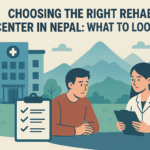Urban and rural areas face unique challenges, yet the need for rehabilitation in both settings is more intertwined than ever. As cities expand and rural regions strive to retain their vitality, comprehensive rehabilitation projects play a crucial role in shaping resilient, thriving communities. This blog explores why rehabilitation matters for urban and rural areas, the benefits it offers, and strategies for successful implementation.
Understanding Rehabilitation in Urban and Rural Contexts
Rehabilitation is a multifaceted process aimed at reviving underdeveloped or decaying infrastructures and social systems. Whether in densely populated cities or in sparsely populated rural communities, the goal remains the same: to enhance living conditions, boost economic opportunities, and promote sustainable development.
What Is Urban Rehabilitation?
Urban rehabilitation typically focuses on revitalizing city spaces that have deteriorated over time due to industrial decline, overpopulation, or neglect. This can include:
- Infrastructure Upgrades: Renovating buildings, roads, bridges, and public transportation systems to meet modern standards.
- Affordable Housing: Transforming old or dilapidated housing into safe, affordable, and energy-efficient homes.
- Public Spaces: Revitalizing parks, community centers, and other public areas to foster social interaction and community pride.
- Economic Renewal: Encouraging mixed-use developments and commercial revitalization that boost local economies.
What Is Rural Rehabilitation?
In rural settings, rehabilitation addresses challenges that are often rooted in geographic isolation and limited resources. Key components include:
- Agricultural Modernization: Upgrading tools, technology, and infrastructure to support local agriculture and food production.
- Access to Basic Services: Expanding access to healthcare, education, and utilities, which are essential for improving quality of life.
- Community Development: Investing in local businesses, enhancing transportation networks, and preserving cultural heritage.
- Sustainable Practices: Implementing eco-friendly methods that protect natural resources and promote long-term environmental health.
The Importance of Urban Rehabilitation
Urban areas are the engines of economic growth, yet many cities grapple with issues such as overcrowding, aging infrastructure, and socio-economic disparities. Rehabilitation in these contexts is critical for several reasons:
Enhancing Quality of Life
Modernizing infrastructure directly improves residents\’ day-to-day experiences. Upgraded public transportation, revitalized housing, and improved public spaces contribute to safer and more livable environments. For instance, transforming old neighborhoods into vibrant communities not only boosts morale but also attracts new investments.
Boosting Economic Development
Urban rehabilitation projects often serve as catalysts for economic rejuvenation. Revitalized areas attract businesses, tourists, and new residents, creating a ripple effect that increases job opportunities and stimulates local economies. Mixed-use developments that integrate residential, commercial, and recreational spaces can lead to sustained economic growth and innovation.
Promoting Sustainability
Many urban rehabilitation projects now emphasize sustainability, focusing on energy-efficient buildings, green spaces, and waste reduction. These initiatives not only reduce environmental impact but also set the stage for future growth in a way that prioritizes long-term ecological balance.
Addressing Social Equity
Rehabilitation efforts in cities frequently target underserved areas, aiming to reduce social inequities. By investing in affordable housing, community centers, and accessible public services, urban rehabilitation helps bridge the gap between different socio-economic groups, fostering more inclusive communities.
The Importance of Rural Rehabilitation
Rural communities often serve as the backbone of a nation’s food production, culture, and heritage. However, many rural areas struggle with issues like limited access to healthcare, outdated infrastructure, and economic stagnation. Rehabilitation in rural areas is vital for several reasons:
Revitalizing Local Economies
Rural rehabilitation projects can stimulate economic growth by improving transportation networks, expanding broadband access, and modernizing agricultural practices. These changes not only attract new investments but also empower local communities to diversify their economies beyond traditional industries.
Improving Access to Essential Services
Many rural residents face significant challenges in accessing healthcare, education, and reliable utilities. Rehabilitation efforts that focus on building and upgrading facilities can drastically improve the quality of life in these regions. For example, constructing new clinics or schools and ensuring that existing structures meet modern standards are critical steps toward comprehensive rural development.
Preserving Cultural Heritage and Community Identity
Rural rehabilitation is not solely about modernization—it also involves preserving the cultural and historical essence of a community. Projects that restore historic buildings or create community centers can help maintain local traditions and strengthen community bonds, ensuring that progress does not come at the expense of identity.
Promoting Sustainable Development
Rural areas are often closely connected to the natural environment. Sustainable rehabilitation practices, such as adopting renewable energy solutions and promoting eco-friendly agriculture, can help protect natural resources while fostering economic development. This balance is crucial for ensuring that rural areas remain vibrant and sustainable for future generations.
Benefits of Comprehensive Rehabilitation Efforts
Whether in urban or rural settings, rehabilitation projects offer numerous benefits that extend beyond mere physical improvements:
Enhanced Public Safety and Health
Upgrading infrastructure often leads to safer living conditions. Better road designs, improved lighting, and modernized public facilities reduce the risk of accidents and promote overall community health. Enhanced healthcare facilities and recreational spaces also contribute to a higher quality of life.
Economic Resilience
Investments in rehabilitation can lead to a more diversified and resilient local economy. By creating job opportunities, attracting new businesses, and fostering local entrepreneurship, communities can better withstand economic downturns and market fluctuations.
Environmental Sustainability
Modern rehabilitation projects often integrate green technologies and sustainable practices. Energy-efficient buildings, improved waste management systems, and the creation of green spaces contribute to environmental conservation, reducing carbon footprints and promoting a healthier ecosystem.
Social Cohesion and Community Empowerment
Rehabilitation efforts that involve community participation can foster a sense of ownership and pride among residents. By engaging local stakeholders in the planning and execution process, projects are more likely to meet the actual needs of the community, thereby strengthening social bonds and encouraging civic engagement.
Challenges in Rehabilitation Projects
Despite the many benefits, urban and rural rehabilitation initiatives face several challenges that must be addressed for successful implementation:
Funding Constraints
One of the most significant hurdles is securing sufficient funding. Rehabilitation projects, particularly large-scale ones, require substantial investment. Innovative financing methods, such as public-private partnerships and government grants, are essential to overcome these financial barriers.
Political and Administrative Hurdles
Navigating bureaucratic processes and political dynamics can delay or complicate rehabilitation efforts. Ensuring transparency, efficient planning, and interdepartmental coordination are vital for overcoming these obstacles.
Balancing Modernization with Heritage Preservation
In both urban and rural areas, there is often tension between the need for modernization and the desire to preserve historical and cultural landmarks. A balanced approach that respects heritage while introducing modern amenities is crucial for community acceptance and long-term success.
Community Resistance to Change
Even well-intentioned rehabilitation projects can face resistance from local communities, particularly if residents feel that changes may disrupt their way of life. Effective communication, community involvement, and inclusive planning are key to addressing such concerns.
Strategies for Successful Rehabilitation
Achieving meaningful rehabilitation in urban and rural settings requires a multi-pronged approach that addresses both immediate needs and long-term goals. Consider the following strategies:
Inclusive Planning and Community Engagement
- Stakeholder Involvement: Engage residents, local businesses, and community leaders from the outset to ensure that projects meet local needs.
- Transparent Communication: Clearly communicate the goals, benefits, and potential challenges of rehabilitation projects to build trust and encourage public support.
Leveraging Public-Private Partnerships
- Innovative Financing: Explore partnerships between government entities and private investors to pool resources and share risks.
- Collaborative Execution: Work with local businesses, non-profits, and community organizations to implement projects efficiently and effectively.
Prioritizing Sustainable Practices
- Green Technologies: Incorporate energy-efficient designs, renewable energy sources, and eco-friendly materials in rehabilitation projects.
- Long-Term Impact: Focus on initiatives that not only address immediate issues but also contribute to the long-term resilience and sustainability of the community.
Addressing Socio-Economic Inequities
- Affordable Housing: Ensure that rehabilitation projects include provisions for affordable housing and support services for low-income residents.
- Access to Services: Prioritize improvements in healthcare, education, and public transportation to ensure equitable access for all community members.
Future Outlook: Integrating Urban and Rural Rehabilitation
The future of rehabilitation lies in a balanced approach that integrates both urban and rural development strategies. As cities and countryside areas become increasingly interconnected, a comprehensive rehabilitation blueprint can serve as a model for nationwide and even global progress.
Bridging the Urban-Rural Divide
Efforts to rehabilitate both urban and rural areas can help bridge the divide that often separates these communities. By sharing resources, knowledge, and best practices, both regions can benefit from a more cohesive and resilient development strategy.
Innovation and Technology as Catalysts
Emerging technologies—such as smart city infrastructure, renewable energy solutions, and digital connectivity—offer new opportunities for rehabilitation projects. By harnessing these innovations, communities can achieve higher efficiency, better resource management, and improved quality of life.
Policy and Governance Reforms
For rehabilitation projects to succeed, supportive policies and streamlined governance structures are essential. Local and national governments must work collaboratively to create regulatory environments that encourage investment, innovation, and sustainable development.
Urban and rural rehabilitation is more than just a process of physical renewal—it is a pathway to creating healthier, more inclusive, and sustainable communities. By addressing the unique challenges of both urban decay and rural underdevelopment, rehabilitation projects can stimulate economic growth, enhance public safety, and promote social equity.
As we look to the future, a holistic approach that integrates urban and rural rehabilitation will be key to building resilient communities. Whether it’s upgrading outdated infrastructure, preserving cultural heritage, or adopting green technologies, every effort counts in transforming our living spaces for the better.
Ultimately, investing in rehabilitation is investing in our future. By prioritizing these initiatives, we pave the way for a more connected, prosperous, and sustainable world—one community at a time.




